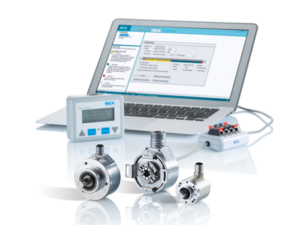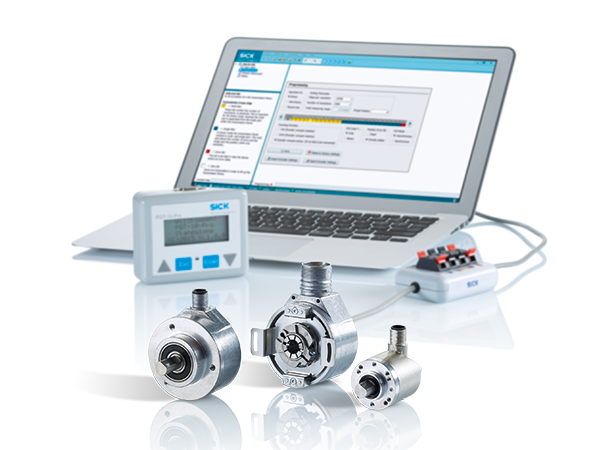What is the difference between traditional encoders and programmable encoders?
 A traditional optical encoder is a very simple sensor that uses a fixed code disc to produce an electrical signal, usually a square wave output. When the disc is rotated between a light source and a photodiode, the output signal corresponds to the light being passed through or blocked from the photodiode. The number of times the signal is high corresponds to the number of slots on the code disc, which is typically referred to as the line count, resolution, or pulses per revolution.
A traditional optical encoder is a very simple sensor that uses a fixed code disc to produce an electrical signal, usually a square wave output. When the disc is rotated between a light source and a photodiode, the output signal corresponds to the light being passed through or blocked from the photodiode. The number of times the signal is high corresponds to the number of slots on the code disc, which is typically referred to as the line count, resolution, or pulses per revolution.
Historically, code discs contained a fixed line count, which increased manufacturing and production constraints if a different or higher resolution was required. Therefore, any changes to the customer’s requirements meant obtaining a new encoder and increasing inventoried parts, resulting in higher costs. In addition, manufacturers are required to stock all parts needed to build any specific encoder configuration, or risk excessive lead times to fulfill customers’ basic delivery needs.
A programmable encoder, like the DFS family from SICK, operates in the same way as a traditional encoder, but it can be programmed to any line count in either the field or during production.
Keep reading for four proven advantages of using programmable encoders in your manufacturing processes.
1. Reduce Costs
The most obvious advantage of programmable encoders is the reduction of replacement and inventory costs. Instead of stocking encoders of different line counts, one programmable encoder will suffice. However, as any frequent user of encoders may realize, programming only the line count does not account for other parameters, such as the output signal voltage or marker pulse alignment. The best option is to obtain an encoder that offers several programmable parameters.
For example, the DFS incremental encoder from SICK features a programmable line count as well as a programmable electrical interface. In addition, the AFS/AFM series of programmable absolute encoders offers various features that are programmable depending on the interface selected.
2. Save Time
Setting the marker pulse at any given point based on the user’s preference reduces setup time of an encoder. Usually, when an incremental encoder is installed, the marker/zero pulse is used as a reference signal. In some applications, an oscilloscope is used to monitor the channel so the encoder shaft can be carefully adjusted to trace the starting point.
With the DFS series, the marker pulse can be programmed via the easy-to-use programming interface, or set remotely by applying a signal on a dedicated pin. This saves a great deal of time and energy during installation, especially when replacing an existing encoder with the need to align to the same marker position. With the AFS/AFM absolute series, the zero position can be remotely set via programming, by an external signal, or over the network, depending on the electrical interface used.
3. Gain Flexibility
Another great benefit of using programmable encoders is the flexibility they offer. Programmability offers the ability to match any changing needs of the end user. A key differentiation that SICK’s encoders offer is the ability to program any integer line count (between 1 to 65,536 on DFS60 incremental encoders and up to 18 bits on AFS/AFM60 absolute encoders) without being restricted to binary line counts only.
The encoders can be reprogrammed as many times as needed by the user; the high resolution removes the need for any additional interpolation and gives a high degree of accuracy and precision that is needed for most applications.
4. Improve Diagnostics/Condition Monitoring
The programming software interface can be used as a condition monitoring tool as well as for monitoring parameters like position or angle during the initial integration, or when performing maintenance or making adjustments while running operations.
Programming tools can be used in the field to remotely read label information of encoders that are not easily accessible, reading the electrical parameters that the programmable encoders are currently set to and also testing operation of the encoder when in use on the line by displaying the position and pulse count data.
This helps users quickly identify encoders for replacement, read the electrical settings of the encoder and make any changes as needed on the line. These additional diagnostic and monitoring capabilities help maintenance personnel identify problems quickly, reducing downtime.





